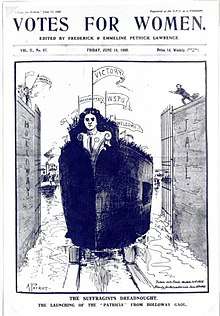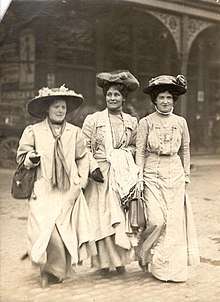Ada Flatman
Ada Susan Flatman (1876 – 1952) was a British suffragette in the UK and in the US.
Ada Flatman | |
|---|---|
 | |
| Born | 1876 |
| Died | 1952 Eastbourne, England, United Kingdom |
| Nationality | British |
Life
Flatman was born in Suffolk in 1876. She was on independent means and she became interested in women's rights. She lived in the same Twentieth Century Club Notting Hill rooms as fellow activist Jessie Stephenson.[1]
Flatman was sent to Holloway Prison[2] after she took part in the "raid" on the Houses of Parliament in 1908, led by Marion Wallace-Dunlop, Ada Wright and Katherine Douglas Smith, and a second wave by Una Dugdale.[1] The following year she was employed by the WSPU to organise their activities in Liverpool[3] taking over from Mary Phillips.[4] Flatman arranged humble lodgings for Constance Lytton when she came to Liverpool disguised as a working woman, aiming to get arrested for suffragette activism to created suitable publicity.[1] In July 1910, Flatman was a key speaker at one of the platforms in the 10,000 women's rally at Hyde Park.[1]as

Flatman worked with Dr Alice Stewart Ker, but it was Ada who was trusted by Emmeline Pethick when Liverpool requested that they be allowed to open a WSPU shop. The shop was set up for her by Patricia Woodlock and became a success and it raised substantial funds for the cause.[5] Flatman organised the publicity surrounding the release of Patricia Woodlock who had completed a prison term in Holloway. A 1909 copy of Votes for Women depicted "Patricia" as a Dreadnought.[4] When Flatman stepped down as branch co-ordinator suddenly in 1910, over a difference in approach to campaigning, Alice Morrissey took over as volunteer branch organiser until another staff member was appointed to lead them.[6]
The first world war started in 1914 and the leading suffrage organisations agreed to suspend their protest until the war was over. Many activists disagreed and Ada Flatman, living in Bristol,[1] was one. Flatman joined the Women's Emergency Corps., founded by Evelina Haverfield.[1] Flatman decided to carry on her work in the US and she emigrated to the US to work for Alice Paul's The Suffragist newspaper in 1915.[5] She became their Business and Advertising manager.[7] After the war was completed she was keen to carry on the work but organisations in America and South Africa did not accept her offer of assistance.[5] Flatman returned to England in the 1930s, and was a peace campaigner,[1] and supported the work of Edith How-Martyn in later documenting the movement in the Suffragette Fellowship. [8]
Flatman died in Eastbourne in 1952.[5]
Legacy
Flatman's reminiscences were recorded by the BBC.[2] She had also kept a scrapbook of her suffrage adventures and that book is held by the Museum of London.[3]
References
- Atkinson, Diane (2018). Rise up, women! : the remarkable lives of the suffragettes. London: Bloomsbury. pp. 98, 115, 191, 212, 536. ISBN 9781408844045. OCLC 1016848621.
- "BBC - Archive - Suffragettes - A Talk by Ada Flatman". www.bbc.co.uk. Retrieved 2019-02-08.
- "Shades of Militancy: the forgotten Suffragettes". Museum of London. Retrieved 2019-02-08.
- Cowman, Krista (November 1994). "Engendering Citizenship" The Political Involvement of Women on Merseyside, 1890-1920 (PDF) (PhD thesis). University of York. Archived (PDF) from the original on 8 February 2019. Retrieved 8 April 2019.
- "Ada Flatman". Spartacus Educational. Retrieved 2019-02-08.
- Cowman, Krista, 1964- (2004). Mrs. Brown is a man and a brother : women in Merseyside's political organisations, 1890-1920. Liverpool: Liverpool University Press. ISBN 978-1-84631-360-8. OCLC 276174298.CS1 maint: multiple names: authors list (link)
- "Search results from Women of Protest: Photographs from the Records of the National Woman's Party". Library of Congress, Washington, D.C. 20540 USA. Retrieved 2019-02-08.
- "Museum of London | Free museum in London". collections.museumoflondon.org.uk. Retrieved 2019-08-01.
